The variety of our rice is not limited to the Uonuma Koshihikari.
Award-winning rice, organic rice and other special rice are sourced from across Japan. We are proud of the high quality variety and encouraged by the support of leading chefs and food critics. |
| We are proud that food professionals chose our rice. |
| By appointment to the top restaurants |
| The Michelin Restaurant Guide three-starred restaurant Kanda in Tokyo and the Michelin Kyoto's one starred Miyamaso buy rice from Zen. The Kanda uses "Kiyoshi Suzuki's rice" and the Miyamaso uses "Kazuo Suzuki's rice." The Kanda and the Miyamaso independently judge our rice as "the most delicious rice." Such a selection by such first-class restaurants is a good encouragement for the farmers and our company as well.
The happiest news for rice producers is brought with yearly orders. A voice from customers, such as "very good rice, we'll order the same rice next year too," stimulates the farmers' motivation. Some farmers' rice is quickly sold out upon opening orders in March.
|
  |
|
| We have two "rice sommeliers." |
| The rice taste connoisseurs |
| Michelin-starred chefs and other food professionals choose our rice because its taste is credible. We have two qualified rice taste connoisseurs in our company, who check the subtle differences of taste through on-the-spot investigation and rice taste evaluation. To confirm each taste, we set strict standards and methods of evaluation; we use more than 4 rice cookers and earthenware to test each variety.
Rice that may seem promising at the initial point of on-the-spot investigation may well turn out unsatisfactory. Although organic rice is believed to taste good, academic investigation cannot reveal aspects of taste.
Our connoissurs have carried out more than 1000 tests and tastings to identify the few varieties that met our rigorous standards of taste.
|
  |
|
| The taste differs after spring. |
| Snow storehouse |
| An appropriate method of preservation is vital to preserve rice taste. The taste deteriorates when preserved at room temperature, no matter how tasty it originally was. Most conscious rice vendors keep their rice at around 15℃ to prevent deterioration. Zen's rice is preserved in a snow storehouse (Yukimuro), a natural storehouse where the snow gathered in winter helps keep the temperature 0℃ till next autumn.
Although the snow storehouse idea is a great way to utilize the natural environment, it still needs further research and improvement. There have been cases reported of some becoming affected by mold because of humidity. We have been wary of such problems and researching the technology of snow storehouses with a view to building one of our own. At the moment, we rent an up-to-date snow storehouse in Yamagata. Needless to say, it is mold-free.
|
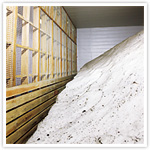  |
|
| We assure the best taste |
| Polishing rice just before delivery |
| The taste of rice deteriorates if the quality is not controlled up to the point of shipment, whether or not preserved in a snow storehouse. We periodically transfer only the necessary amount of rice from the storehouse in Yamagata to the company's low temperature storeroom (15℃, humidity 65 %). Especially in summer, the quality is monitored carefully with more frequent transference.
In addition, we polish the rice just before shipment to customers. The polishing machine is always kept in good condition. Upon request, we can also supply the rice unpolished (with the germ).
* The rice with the germ appears yellowish, but it tastes better. Please ask for it on order.
* After it is polished, we recommend the rice be refrigerated to prevent deterioration in taste.
|
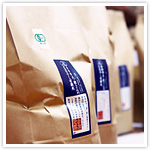 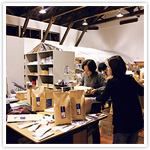 |
|
| 20 years of editorial experience is our asset. |
| Research skill |
| "How do you find good rice?," we are often asked. The answer is "We use thorough research."
The requirements for good rice are not only the abundant supply of pure water and good soil, but also the appropriately sited land. We check the Survey Institute maps first, and then consult aerial photography and geographical data produced by various research institutes to assess likely areas of good rice production.
After a target area is chosen, we taste its rice and that of the surrounding area. We investigate the method of farming, the soil, the variety of living creatures and weeds of the locality, and the source of water. Lastly comes the tasting by the rice taste connoisseurs. This is the method we employ for all of our original brand products.
|
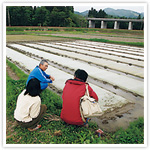 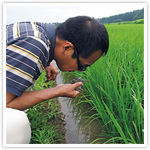 |
|
|
|



